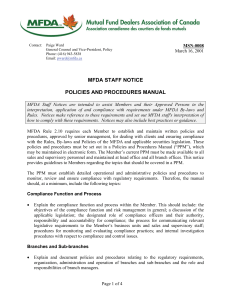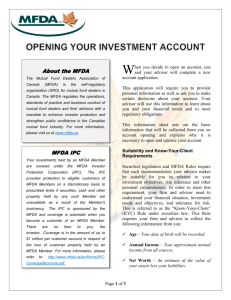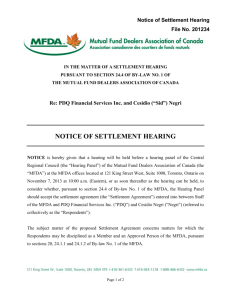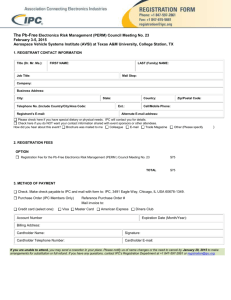MFDA Investor Protection Corporation Financial Statements 2011
advertisement
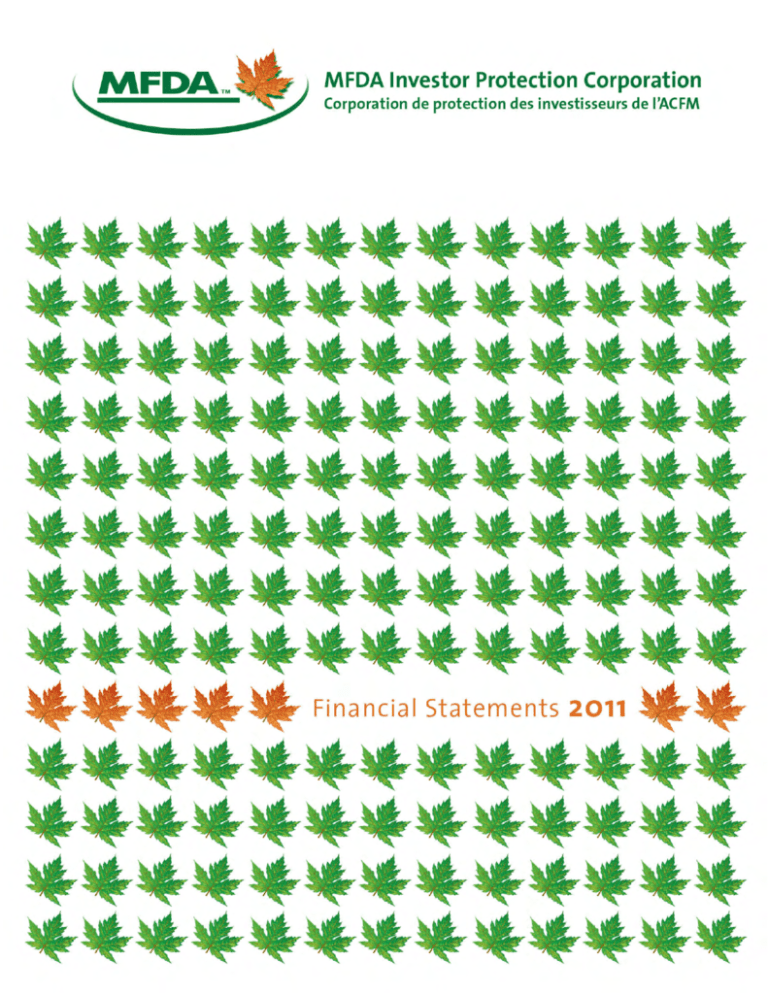
Table of Contents Independent Auditor’s Report 1 Balance sheets 2 Statements of revenues and expenses and changes in fund balance 3 Statements of cash flows 3 Notes to the financial statements 4–10 Independent Auditor’s Report To the Members of the Board of Directors of MFDA Investor Protection Corporation Report on the Financial Statements We have audited the accompanying financial statements of MFDA Investor Protection Corporation, which comprise the balance sheets as at June 30, 2011 and 2010, and the statements of revenues and expenses and changes in fund balances and statements of cash flows for the years then ended, and a summary of significant accounting policies and other explanatory information. Management’s Responsibility for the Financial Statements Management is responsible for the preparation and fair presentation of these financial statements in accordance with Canadian generally accepted accounting principles, and for such internal control as management determines is necessary to enable the preparation of financial statements that are free from material misstatement, whether due to fraud or error. Auditor’s Responsibility Our responsibility is to express an opinion on these financial statements based on our audits. We conducted our audits in accordance with Canadian generally accepted auditing standards. Those standards require that we comply with ethical requirements and plan and perform the audits to obtain reasonable assurance about whether the financial statements are free from material misstatement. An audit involves performing procedures to obtain audit evidence about the amounts and disclosures in the financial statements. The procedures selected depend on the auditor’s judgment, including the assessment of the risks of material misstatement of the financial statements, whether due to fraud or error. In making those risk assessments, the auditor considers internal control relevant to the entity’s preparation and fair presentation of the financial statements in order to design audit procedures that are appropriate in the circumstances, but not for the purpose of expressing an opinion on the effectiveness of the entity’s internal control. An audit also includes evaluating the appropriateness of accounting policies used and the reasonableness of accounting estimates made by management, as well as evaluating the overall presentation of the financial statements. We believe that the audit evidence we have obtained is sufficient and appropriate to provide a basis for our audit opinion. Opinion In our opinion, the financial statements present fairly, in all material respects, the financial position of MFDA Investor Protection Corporation as at June 30, 2011 and 2010, and the results of its operations and its cash flows for the years then ended in accordance with Canadian generally accepted accounting principles. Chartered Accountants Licensed Public Accountants September 12, 2011 MFDA INVESTOR PROTECTION CORPORATION 1 Balance Sheets as at June 30 Assets Current Cash Investments (Note 3) Assessments receivable from the MFDA (Note 4) Interest and other receivable Liabilities and Fund Balance Current Accounts payable and accrued liabilities Support costs due to the MFDA (Note 5) Funding balance Operating Fund Unrestricted net assets The accompanying notes are an integral part of these financial statements. Approved on behalf of the Board “David Richards” Director “Beat Guldimann” Director MFDA INVESTOR PROTECTION CORPORATION 2 2011 $ 2010 $ 200,652 30,071,976 144,953 30,417,581 244,116 27,462,563 58,109 121,635 27,886,423 130,392 16,969 147,361 81,138 15,878 97,016 30,270,220 30,270,220 30,417,581 27,789,407 27,789,407 27,886,423 Statements of Revenues and Expenses and Changes in Fund Balance for the years ended June 30 Operating Fund Revenues Assessments of MFDA Members (Note 7) Investment and other income (Note 8) Total revenues Expenses Consultants Legal Bank charges (Note 6) Board of Directors - fees and expenses Investment management fees MFDA support charges (Note 5) Insurance Audit fees Communications and annual report Office and general Total expenses Excess of revenues over expenses and comprehensive income Fund balance, beginning of year Fund balance, end of year 2011 $ 2010 $ 2,568,232 713,294 3,281,526 5,030,220 500,020 5,530,240 193,190 155,604 126,630 94,614 79,311 67,800 47,990 21,159 11,272 3,143 800,713 118,810 61,494 134,035 81,126 63,233 63,000 47,990 19,064 5,894 641 595,287 2,480,813 27,789,407 30,270,220 4,934,953 22,854,454 27,789,407 2011 $ 2010 $ 2,480,813 4,934,953 58,109 (23,318) 49,254 1,091 2,565,949 (43,009) (61,393) 17,310 2,264 4,850,125 (2,609,413) (2,609,413) 1,882,559 (6,686,393) (4,803,834) (43,464) 244,116 200,652 46,291 197,825 244,116 The accompanying notes are an integral part of these financial statements. Statements of Cash Flows for the years ended June 30 Operating activities Excess of revenues over expenses and comprehensive income - Operating Fund Changes in non-cash working capital Assessments receivable from the MFDA Interest and other receivable Accounts payable and accrued liabilities Support costs due to the MFDA Investing activities Proceeds from sale of investments Purchase of investments (Decrease)/Increase in cash during the year Cash, beginning of year Cash, end of year The accompanying notes are an integral part of these financial statements. MFDA INVESTOR PROTECTION CORPORATION 3 Notes to the Financial Statements June 30, 2011 and 2010 1. Nature of the organization The MFDA Investor Protection Corporation (“MFDA IPC”) was incorporated as a not-for-profit corporation on November 14, 2002 under Part II of the Canada Corporations Act. The purpose of the MFDA IPC is to administer an investor protection fund for the benefit of clients of mutual fund dealers that are Members of the Mutual Fund Dealers Association of Canada (“MFDA”). The MFDA IPC protects client assets held by a MFDA Member firm in the event that the Member firm becomes insolvent. The securities commissions approved the creation of MFDA IPC in May 2005, and the MFDA IPC began offering coverage on July 1, 2005. 2. Significant accounting policies The financial statements have been prepared by management in accordance with Canadian generally accepted accounting principles. Because the precise determination of many assets and liabilities such as accrued liabilities is dependent upon future events, the preparation of financial statements for a period necessarily involves the use of estimates and approximations that have been made using judgment. Actual results could differ from those estimates. The financial statements have, in management’s opinion, been properly prepared within reasonable limits of materiality and within the framework of the accounting policies summarized below. Fund accounting The MFDA IPC uses the deferral method of accounting for not-for-profit organizations in the preparation of its financial statements. At this time there is only one fund, the Operating Fund. The Operating Fund accounts for the regular business and activities of the MFDA IPC. Member assessments MFDA Members are assessed MFDA IPC dues annually and are invoiced on a quarterly basis. Assessment revenues are recorded monthly. The assessments are calculated using a defined formula based on each Member’s assets under administration. The assessments are invoiced and collected by the MFDA on behalf of the MFDA IPC. The funds are subsequently transferred to the MFDA IPC. Provision for income taxes The MFDA IPC is a not-for-profit organization within the meaning of the Income Tax Act (Canada). Accordingly, there is no provision for income taxes in these financial statements. Cash Cash includes cash on hand and balances with banks, net of bank overdrafts and excludes cash balances in investment accounts, which are presented as investments. MFDA INVESTOR PROTECTION CORPORATION 4 2. Significant accounting policies (continued) Investments The MFDA IPC invests in high rated federal and provincial government and Crown Corporation bonds with short-term to medium-term maturities and in Canadian provincial and federal treasury bills or notes with short-term maturities. Investments in bonds are classified as Held to Maturity (“HTM”) and are recorded at amortized cost. Any gains and losses are recognized in the Statements of Revenues and Expenses in the period that the asset is sold or becomes permanently impaired. Interest income from the bonds is accrued daily and recorded under Investment and other income in the Statements of Revenues and Expenses. Interest income includes the amortization of bond premiums or the accretion of bond discounts, calculated using the effective interest rate method. Investments in Canadian federal or provincial treasury bills or notes are classified as Held for Trading (“HFT”) and are recorded at fair value with any unrealized gains and losses being recorded in the Statements of Revenues and Expenses. As these instruments are short term in nature, cost approximates fair value. Any realized gains and losses are recognized in the Statements of Revenues and Expenses in the period that the asset matures, is sold or becomes permanently impaired. Interest income from the bonds is accrued daily and recorded under Investment and other income in the Statements of Revenues and Expenses. Provision for claims and related expenses Provision for claims from customers of insolvent MFDA Members and related expenses is made when the MFDA IPC is notified of potential claims and expects to incur expenses related to the claim. No amounts have been provided for in the current period. No amounts are provided as a contingency to cover possible losses and customer claims for claims not yet reported. Future accounting changes In December 2010, the CICA issued a new accounting framework applicable to Not-for-Profit Organizations. Effective for fiscal years beginning on or after January 1, 2012, not-for-profit organizations will have to choose between International Financial Reporting Standards (IFRSs) and Canadian accounting standards for Not-for-Profit Organizations. Early adoption of these standards is permitted. The MFDA IPC currently plans to adopt the Canadian accounting standards for Not-for-Profit Organizations for its fiscal year beginning July 1, 2012. The impact of transitioning to these new standards has not been determined at this time. MFDA INVESTOR PROTECTION CORPORATION 5 3. Investments The following table lists the investment holdings and their carrying and fair values as at June 30, 2011. All investments are classified as Level 2. Investment Bonds Canada Housing Trust, 4.60%, Mat. Sep 15 2011 New Brunswick Provincial, 5.875%, Mat. Dec 06 2012 Financement Quebec, 4.50%, Mat. Dec 01 2016 Canada Housing Trust, 3.60%, Mat. Jun 15 2013 Financement Quebec, 4.25%, Mat. Mar 01 2014 Ontario Provincial, 4.50%, Mat. Mar 08 2015 B.C. Provincial, 4.70%, Mat. Dec 01 2017 Ontario Provincial, 4.40%, Mat. Jun 02 2019 Canada Government, 4.25%, Mat. Jun 01 2018 Canada Housing Trust, 3.75%, Mat. Mar 15 2020 Sub-Total Bonds Cash on hand for bond investment Treasury Bills and Notes Canada Government, 0.986%, Mat. Aug 4 2011 Canada Government, 0.990%, Mat. Aug 18 2011 Canada Government, 1.024%, Mat. Sep 15 2011 Canada Government, 1.23%, Mat. Sep 29 2011 Sub-Total Treasury Bills and Notes Cash on hand for T-Bills investment Par value ($)/ number of units Designation Credit rating Carrying value $ Fair value $ 1,700,000 Held To Maturity AAA 1,700,210 1 ,711,645 1,600,000 Held To Maturity Ah 1,633,810 1 ,696,896 1,600,000 Held To Maturity Ah 1,592,830 1 ,730,832 1,820,000 Held To Maturity AAA 1,870,775 1 ,887,395 1,730,000 Held To Maturity Ah 1,804,138 1 ,830,496 1,720,000 Held To Maturity AA1 1,815,901 1 ,852,457 1,550,000 Held To Maturity AAh 1,652,572 1 ,697,901 1,580,000 Held To Maturity AA1 1,632,223 1 ,676,506 1,500,000 Held To Maturity AAA 1,585,777 1 ,646,220 1,670,000 Held To Maturity AAA 1,657,284 16,945,520 1 ,724,793 17,455,141 N/A N/A N/A 297,242 297,242 3,775,000 Held for Trading AAA 3,765,034 3 ,765,034 4,375,000 Held for Trading AAA 4,363,406 4 ,363,406 2,625,000 Held for Trading AAA 2,618,280 2 ,618,280 2,075,000 Held for Trading AAA 2,069,999 12,816,719 2 ,069,999 12,816,719 N/A N/A N/A 12,495 12,495 30,071,976 30,581,597 Total Investments MFDA INVESTOR PROTECTION CORPORATION 6 3. Investments (continued) The following table lists the investment holdings and fair values as at June 30, 2010: Investment Bonds Canada Housing Trust, 4.60%, Mat. Sep 15 2011 New Brunswick Provincial, 5.875%, Mat. Dec 06 2012 Financement Quebec, 4.50%, Mat. Dec 01 2016 Canada Housing Trust, 3.60%, Mat. Jun 15 2013 Financement Quebec, 4.25%, Mat. Mar 01 2014 Ontario Provincial, 4.50%, Mat. Mar 08 2015 B.C. Provincial, 4.70%, Mat. Dec 01 2017 Ontario Provincial, 4.40%, Mat. Jun 02 2019 Canada Government, 4.25%, Mat. Jun 01 2018 Canada Housing Trust, 3.75%, Mat. Mar 15 2020 Sub-Total Bonds Cash on hand for bond investment Treasury Bills and Notes Canada Government, 0.219%, Mat. Jul 8 2010 Canada Government, 0.265%, Mat. Jul 22 2010 Canada Government, 0.399%, Mat. Aug 05 2010 Canada Government, 0.406%, Mat. Aug 19 2010 Canada Government, 0.428%, Mat. Sep 02 2010 Canada Government, 0.552%, Mat. Sep 16 2010 Sub-Total Treasury Bills and Notes Cash on hand for T-Bills investment Par value ($)/ number of units Designation Credit rating Carrying value $ Fair value $ 1,640,000 Held To Maturity AAA 1,638,147 1 ,706,223 1,600,000 Held To Maturity Ah 1,656,235 1 ,747,312 1,600,000 Held To Maturity Ah 1,591,690 1 ,705,520 1,570,000 Held To Maturity AAA 1,633,894 1 ,637,871 1,590,000 Held To Maturity Ah 1,682,121 1 ,685,082 1,565,000 Held To Maturity AA1 1,674,012 1 ,678,744 1,550,000 Held To Maturity AAh 1,666,564 1 ,671,954 1,580,000 Held To Maturity AA1 1,637,744 1 ,646,455 1,500,000 Held To Maturity AAA 1,596,629 1 ,643,700 1,650,000 Held To Maturity AAA 1,635,830 16,412,866 1 ,676,945 16,799,806 N/A N/A N/A 292,767 292,767 3,775,000 Held for Trading AAA 3,772,056 3 ,772,056 3,775,000 Held for Trading AAA 3,771,979 3 ,771,979 300,000 Held for Trading AAA 299,709 299,709 1,350,000 Held for Trading AAA 1,348,577 1 ,348,577 1,250,000 Held for Trading AAA 1,248,525 1 ,248,525 300,000 Held for Trading AAA 299,613 10,740,459 299,613 10,740,459 N/A N/A N/A 16,471 16,471 27,462,563 27,849,503 Total Investments MFDA INVESTOR PROTECTION CORPORATION 7 4. Assessments receivable from the MFDA The assessments to MFDA Members billed by the MFDA are due to the MFDA IPC upon collection by the MFDA. The amount of $Nil (2010 - $58,109) represents outstanding amounts from MFDA Members on billings due at June 30, 2011 and 2010. All monies collected by the MFDA had been transferred to the MFDA IPC at year end. 5. Support costs due to the MFDA The MFDA provides the MFDA IPC administrative, corporate secretarial and other support to allow the MFDA IPC to operate without its own staff. The MFDA IPC and the MFDA have entered into a support agreement to define these areas of assistance. The amount of support costs for the year was $67,800 (2010 - $63,000) and was recorded at the agreed upon amount. Payments are made on a quarterly basis in accordance with the support agreement. The MFDA IPC owed the MFDA $16,969 (2010 - $15,878) in respect of support costs as at June 30, 2011. 6. Credit facilities The MFDA IPC has been granted a credit facility limited to a maximum of $30 million (2010 - $30 million) by the Royal Bank of Canada (the “RBC”) (2010 - Canadian Imperial Bank of Commerce (the “CIBC”)). The credit facility, in combination with the investments accumulated by the MFDA IPC, exists to provide protection to customers of Members of the MFDA in the event of loss resulting from an insolvency of a MFDA Member. The MFDA has guaranteed repayment of the $30 million line of credit to the RBC (2010 – CIBC). To date, no amount has been drawn on the line of credit. At June 30, 2011 the interest rate is prime + 0.75% per annum (2010 – prime per annum). In the absence of a drawdown, the RBC (2010 – CIBC) charges a standby fee on the credit line. This charge is included in Bank charges in the Statements of Revenues and Expenses in the amount of $106,111 (2010 - $133,356). 7. Assessments of MFDA members Assessment income for 2011 was $2,568,232 (2010 - $5,030,220). MFDA members were not assessed fees from January 1, 2011 to June 30, 2011. Assessments resumed July 1, 2011. MFDA INVESTOR PROTECTION CORPORATION 8 8. Investment and other income Investment and other income is comprised of the following: 2011 $ - 2010 $ 3,145 718,685 (121,308) 521,658 (52,580) 597,377 469,078 102,524 27,797 102,524 27,797 13,393 - 713,294 500,020 Distributions from money market fund Income from bonds Coupon interest Accretion of the bond discount/premium Income from treasury bills and notes Coupon interest Other income Total investment income Bank interest earned on bond, treasury bills and notes is subject to a minimum cash balance. 9. Risk management Risk management relates to the understanding and active management of risks associated with invested assets. Investments can be indirectly exposed to foreign currency, interest rate, market and credit risk. The MFDA IPC’s investment policy sets out high rated federal and provincial government and Crown Corporation bonds as the allowable bonds for the MFDA IPC bond portfolio. Only federal and provincial notes are allowable for Treasury bill and note investments. The MFDA IPC’s investment policy sets limits on the exposure to individual investments, such as limiting the maximum portfolio exposure to a single province to 20%. Significant risks that are relevant to the MFDA IPC’s investments are as follows: Interest rate risk Interest rate risk refers to the adverse consequences of interest rate changes on the MFDA IPC’s investments. The value of the MFDA IPC’s investments is affected by changes in both nominal and real interest rates as they have a direct impact on the value of fixed income securities. The MFDA IPC’s exposure to interest rate risk arises from its holding of medium-term bonds. The MFDA IPC does not engage in activities to mitigate this risk as it intends to hold these bonds to maturity. Credit risk Credit risk refers to the risk of financial loss due to a counterparty failing to meet its contractual obligations. The MFDA IPC is exposed to credit risk indirectly through its investment in bonds, treasury bills and notes. Credit risk is managed by these funds by limiting exposure to any single counterparty to a small percentage of net assets. Limiting investments to Canadian federal and provincial government bonds and notes and federal and provincial Crown Corporation bonds helps to mitigate the credit risk by investment in high grade investments. In addition, credit risk is managed by the MFDA IPC through dealing with reputable counterparties. As at June 30, 2011 and 2010, the MFDA IPC’s investments in fixed income securities are held with a Tier 1 banking institution. MFDA INVESTOR PROTECTION CORPORATION 9 9. Risk management (continued) Market risk Market risk is the risk that the value of an investment will fluctuate as a result of changes in market conditions, whether these changes are caused by factors specific to the individual investment or factors affecting all securities traded in the market. This risk is mitigated by the MFDA IPC’s policy of diversification of the investment portfolio as well as the narrow field of acceptable high grade investments. Market risk is considered to be minimal. Fair value The fair value of cash, assessments receivable from the MFDA, interest receivable, accounts payable and accrued liabilities, and support costs due to the MFDA, approximates their carrying values due to their short-term nature. The fair value of investments in fixed income securities is based on quoted prices from active markets. 10. Claims paid from Investor Protection Fund There were no claims paid from the MFDA Investor Protection Corporation during the year (2010 - $Nil). 11. Funding and management of assets The MFDA IPC’s capital is its unrestricted net assets. The MFDA IPC’s objectives when managing its unrestricted net assets are: • To safeguard the MFDA IPC’s ability to continue as a going concern, so it can provide protection for the benefit of clients of MFDA Members, and • To work toward Operating Fund reserve targets as set out by the MFDA IPC Board. The MFDA IPC bills MFDA Members annually to ensure operations are funded and to allocate the balance toward the accumulation of the investor protection fund. Prior to the current year, when assessments were not collected for six months (see Note 7), the MFDA IPC billed MFDA Members approximately $5 million annually. Commencing July 1, 2011, the annual fee assessments will be reduced to approximately $2,850,000. As at June 30, 2011, the value of the operating fund unrestricted net assets was $30,270,220 (2010 - $27,789,407). There are no external restrictions on the MFDA IPC’s capital. MFDA INVESTOR PROTECTION CORPORATION 10
